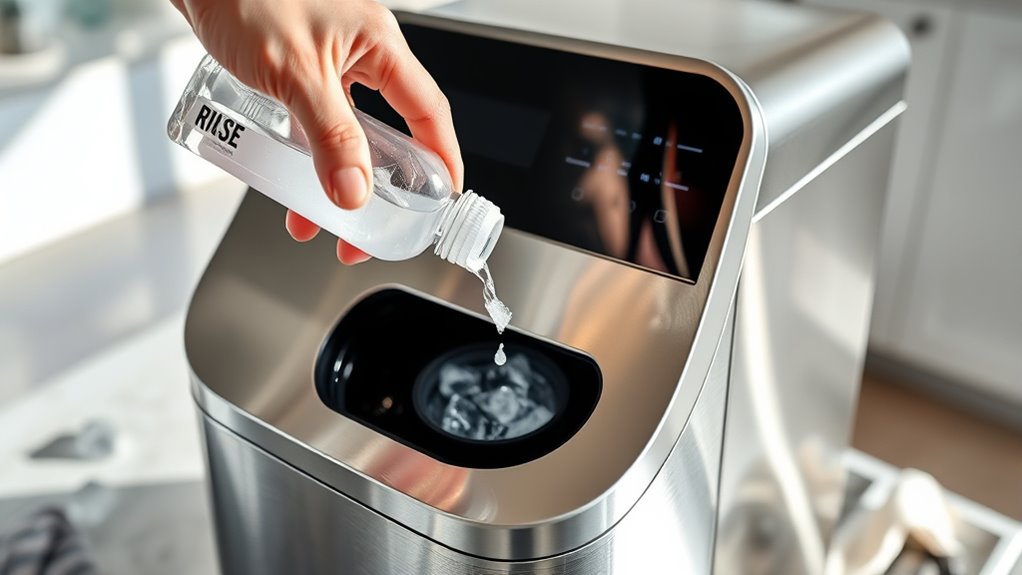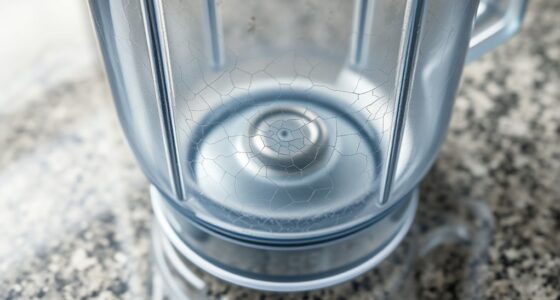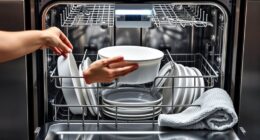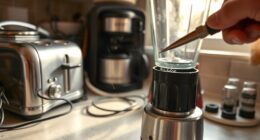To keep your countertop ice maker working well, you should regularly descale and rinse it. Turn off and unplug the machine before cleaning. Remove removable parts like the ice basket and reservoir. Use a descaling solution or a mix of water and vinegar to clean the interior by running a cleaning cycle. Rinse all parts thoroughly with clean water afterward. Continuing with these steps will help maintain fresh ice and ideal performance.
Key Takeaways
- Turn off and unplug the ice maker before starting the descaling and rinsing process.
- Remove removable parts like ice baskets and reservoirs for thorough cleaning.
- Use a commercial descaling solution or a mixture of water and white vinegar to clean the interior.
- Run the descaling cycle with the solution, then thoroughly rinse all parts with clean water.
- Regularly inspect for mineral buildup and perform descaling every few months to maintain optimal performance.
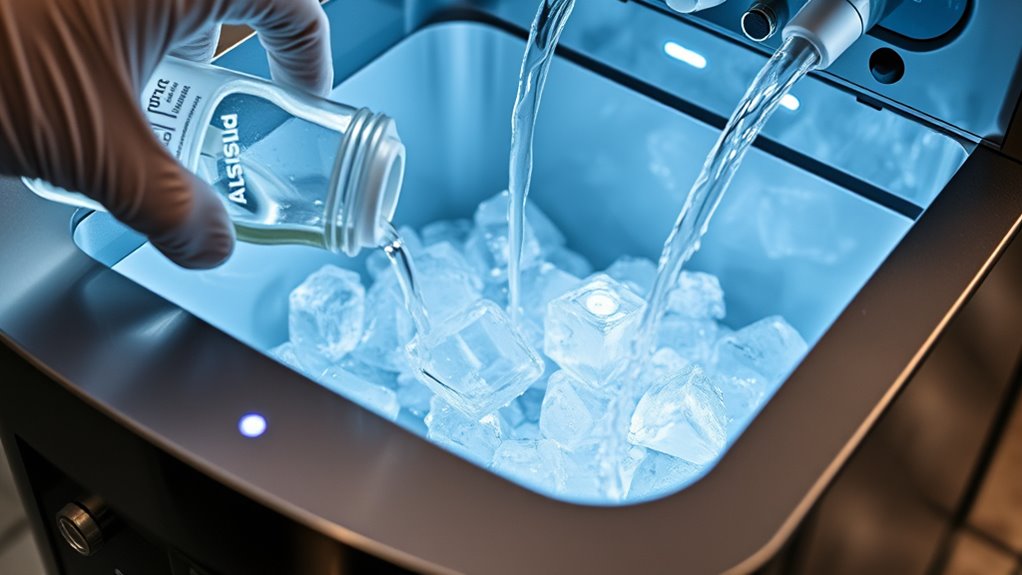
Maintaining your countertop ice maker is essential to guarantee it produces clean, crisp ice and functions efficiently for years to come. One of the most important steps in upkeep is regularly descale and rinse the unit to prevent mineral buildup and ensure top performance. Over time, minerals from tap water can accumulate inside the machine, affecting ice quality and potentially damaging its components. To avoid this, you should follow a consistent cleaning schedule that includes descaling the internal parts and rinsing thoroughly. This process not only prolongs the lifespan of your ice maker but also guarantees that every batch of ice remains fresh and free from impurities.
A key factor in keeping your ice maker in top shape is water filtration. Using filtered water reduces mineral deposits and contaminants that could lead to scale buildup inside the machine. When your water quality improves, you’ll notice cleaner, clearer ice, and your machine will require less frequent descaling. Make sure to regularly check and replace your water filter according to the manufacturer’s instructions, as a clogged or expired filter can compromise water quality and hinder the descaling process. When it’s time to descale, turn off and unplug the machine, then remove any removable parts, such as ice baskets and water reservoirs. Prepare a descaling solution—either a commercial product designed for ice makers or a mixture of equal parts water and white vinegar—and pour it into the water reservoir. Run the cleaning cycle as directed, allowing the solution to circulate through the system and loosen mineral deposits. After the cycle completes, thoroughly rinse all parts with clean water to remove any residual solution or loosened deposits.
Establishing a regular cleaning schedule is vital to maintaining your ice maker’s efficiency. Depending on your usage and water quality, you might need to descale and rinse every few months or more frequently if you notice slower ice production or cloudy ice. During each cleaning, inspect the interior for any signs of buildup or mold and clean the exterior with a damp cloth. Remember, a well-maintained machine not only produces better ice but also reduces the risk of malfunctions and extends its longevity. By prioritizing water filtration and sticking to a consistent cleaning routine, you’ll keep your countertop ice maker running smoothly and ensure every batch of ice is perfectly clear and revitalizing.
Frequently Asked Questions
How Often Should I Replace the Water Filter in My Ice Maker?
You should replace the water filter in your ice maker every 6 months or when it reaches its filter lifespan, whichever comes first. Regularly check your water quality, as poor water may require more frequent changes. A new filter guarantees clean, fresh ice and maintains ideal appliance performance. Don’t wait too long—changing the filter on time keeps your ice maker running smoothly and ensures the best water quality.
Can I Use Vinegar Instead of Commercial Descaling Solutions?
Yes, you can use vinegar as a DIY cleaning alternative instead of commercial descaling solutions. Vinegar effectively breaks down mineral buildup, making it a popular choice for descale your ice maker. Mix equal parts vinegar and water, then run the solution through your machine. Afterward, rinse thoroughly with clean water to remove any vinegar residue. This simple method keeps your ice maker clean and functioning well.
What Are Signs My Ice Maker Needs Professional Repair?
If your ice maker stops producing ice, makes strange noises, or leaks water, it’s time to call a professional. These signs indicate issues beyond simple troubleshooting, requiring expert diagnosis and repair. Regular maintenance tips, like cleaning and descaling, can prevent problems, but persistent malfunctions suggest a need for professional help. Don’t ignore unusual behavior—addressing it early ensures your ice maker works smoothly and lasts longer.
Is It Safe to Use Tap Water for Cleaning?
Using tap water for cleaning your ice maker is generally safe, but it depends on your tap water safety. If your tap water is clean and free of contaminants, you can safely clean with tap water. However, if you’re unsure about water quality, consider using filtered or distilled water for descaling and rinsing. This helps prevent mineral buildup and guarantees your ice maker stays hygienic and functions properly.
How Do I Prevent Mold Growth in My Ice Maker?
To prevent mold growth, you should regularly clean your ice maker to maintain good ice maker hygiene. Keep it dry and clean, especially the interior surfaces and water reservoir. Use a vinegar solution or mild detergent, then rinse thoroughly. Avoid leaving water stagnant for long periods. Consistent maintenance and proper hygiene practices help eliminate mold prevention risks, ensuring your ice stays fresh and safe to use.
Conclusion
Keeping your countertop ice maker clean with regular descaling and rinsing guarantees it runs smoothly and produces ice efficiently. Did you know that neglecting maintenance can reduce your machine’s lifespan by up to 30%? By taking just a few minutes to maintain it, you can save money and enjoy fresh, clear ice whenever you need it. Stay proactive with your maintenance, and your ice maker will serve you well for years to come.
